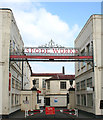1
Site of the Domesday Village of Pinchetel, Penkhull
The stone reads :-
This stone marks the entrance to the former
Iron Age Fort and the Domesday Village
of
Pinchetel
a Royal Manor from 1086
to the time of Edward II
The hill-top village of Penkhull was probably the earliest inhabited place within the area now known as the Potteries, being settled by the Celts, Romans and Anglo-Saxons in turn. It was ideally situated by reason of its wooded hunting grounds, its clear views over the surrounding countryside and its closeness to the streams in the Lyme Valley on the western, and the Trent Valley on the eastern side.
The village may have been protected by a primitive hill-fort, although no remains of such a construction have been discovered. In 1086, the Domesday Book described the Manor of Penkhull (which it called "Pinchetel") as a village of great size, with over 1,000 acres of arable land stretched out over parts of present-day Newcastle-under-Lyme, Hanley, Shelton, Stoke and Boothen.
However, soon after this survey was taken, Penkhull began to decline in importance with the building of a New Castle nearby. A market town quickly grew up within sight of this castle and by the year 1173, the Borough of Newcastle-under-Lyme ("New Castle under the Elm Trees") had been established. This borough was to remain the largest centre of population and leading market town in the area for the next 600 years until the rise of the six towns now called Stoke-on-Trent.
Domesday Listed as :-
PENKHULL. Earl Algar held it. 2 hides, with its dependencies.
Land for 11 ploughs. In lordship 2;
17 villagers and 6 smallholders with 8 ploughs.
Meadow, 2 acres; woodland 1 league long and 2 furlongs wide. Value £6.
Image: © Brian Deegan
Taken: 12 Jul 2020
0.12 miles
2
Stoke church viewed from near the town hall.
The trees help to contrast the old and the new.
Image: © www fotodiscs4u co uk
Taken: 6 Jun 2006
0.12 miles
3
Talbot Hotel - Stoke
Talbot Hotel is at the bottom of Trade Street, Church Street runs along the frontage.
"A popular working-class activity, especially during the Wakes, was the game of 'prison bars'. It was played between two adult teams of eleven by the music of a flute or tin whistle and drum. The game entailed venturing from a den, and capturing opponents who would be taken into a 'prison' and held there until rescued by one of their team mates. It was not for the faint-hearted, and injuries were commonplace.
It was played on fete days on the field - known as Prison Bar Meadow - attached to Norton Hall Farm, whilst a field behind Wedgwood's Etruria Works had been given in perpetuity to locals and that was christened Prison Bars Field.
The Staffordshire Advertiser of August 10th 1850 records that during Stoke Wakes, prison-bar matches took place throughout the week on the race-course at Boothen. The men of Stoke parish beat those from Burslem parish, and all convened afterwards at the Talbot Inn, where the winners received half a sovereign each, and the losers a silk handkerchief each. There were also contests between factory teams from Stoke, Burslem, Hanley and Longton."
Image: © Steven Birks
Taken: 11 Feb 2006
0.15 miles
4
Play area
Image: © Alex McGregor
Taken: 31 Jul 2014
0.16 miles
5
Park
Image: © Alex McGregor
Taken: 31 Jul 2014
0.18 miles
6
Stoke upon Trent market
This single storey market building (built 1900) contains several small shops and also acts as a frontage to an open air market.
Over the main entrance to the market is a relief panel referring the produce of the market, the central image is a bull's head, this is surrounded by game birds, fish, fruit and other produce.
On either wing of the building is a relief panel of the same coat of arms, a quartered shield with several charges.
The building frontage has several slim pilasters which act as divisions between shop fronts. These are topped with ceramic capitals depicting a Green Man-type face amongst foliage.
Image: © Steven Birks
Taken: Unknown
0.19 miles
7
Stoke-on-Trent: The sadly derelict Falcon Works, once the Goss pottery factory
Auction notice attached to the locked gates.
Image: © Michael Garlick
Taken: 2 May 2024
0.21 miles
8
Stoke Bottom Lock
This is the lowest lock of a flight of five on the Trent and Mersey Canal in Stoke. I believe it was rebuilt here in the 1960s when the original line of the canal was moved to accommodate the new road system in the city. This lock has been fabricated out of concrete as opposed to the original which would have been made out of brick/stone.
Image: © Andy Beecroft
Taken: 10 Aug 2004
0.21 miles
9
Entrance to Spode Pottery Works, Stoke
Main entrance to the Spode Pottery Works on Church Street. Established in 1770, the pottery still occupies its original site. The factory chimney is visible behind
Image: © Espresso Addict
Taken: 7 Apr 2007
0.22 miles
10
Courtyard at the former Spode works
This photograph shows a small part of the scene depicted in
Image The gate visible in that picture was locked shut and this photo was taken through a gap in its railings.
Image: © Russ Willey
Taken: 22 Feb 2022
0.22 miles











